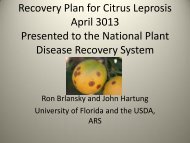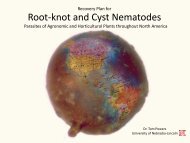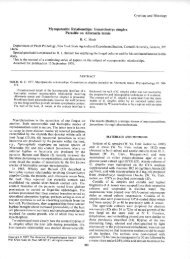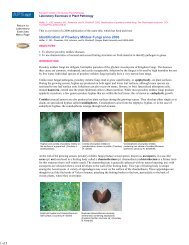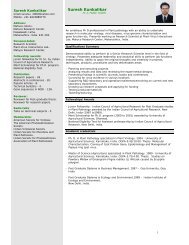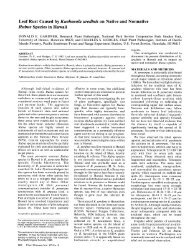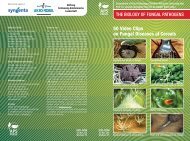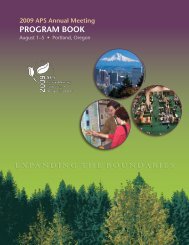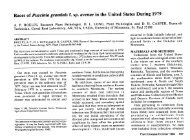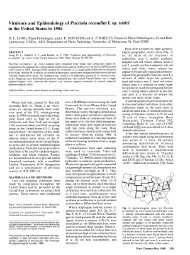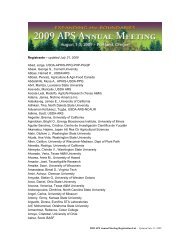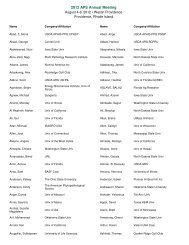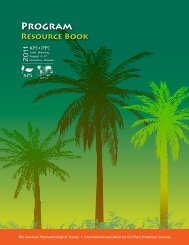view article - American Phytopathological Society
view article - American Phytopathological Society
view article - American Phytopathological Society
You also want an ePaper? Increase the reach of your titles
YUMPU automatically turns print PDFs into web optimized ePapers that Google loves.
A total of 191 somaclones were generated from leaf explants ID 83843 and 3 Kimberly, ID 83341; 2 of 'Bulgaria 12', a tomato cultivar with partial resistance<br />
to Clavibacter michiganensis subsp. michiganensis (CMM),<br />
causal organism of bacterial canker of tomato. Thirty-two<br />
percent of the somaclones were discarded due to abnormal<br />
phenotype or poor growth. One aberrant Rl line produced<br />
currant-type fruit on a vine. Fifty-five R1 progeny were<br />
screened for resistance to CMM in a growth chamber. There<br />
were some variations in reaction to CMM among progeny regenerated<br />
from the same individual callus. A few R1 lines showed<br />
an increased level of resistance to CMM and could prove useful<br />
to plant breeders.<br />
261<br />
Epidemiology and spread of Clavibacter michiganensis subsp.<br />
michiganensis on tomato. R. J. Chang, S. M. Ries and J. K.<br />
Pataky. Dept. of Plant Path., Univ. of Illinois, Urbana.<br />
Harris-Moran Seed Co., San<br />
Juan Bautista, CA 95045.<br />
Black chaff of gramineacious crops, caused by Xanthomonas cam-<br />
pestris pv. translucens (Xct) develops from seedborne inoculum.<br />
A program was established in Idaho to produce Xct-free seed.<br />
In 1987 and 1988, black chaff occurred in spring wheat fields<br />
grown from Xct-free seed at Tetonia and Aberdeen. Epiphytic<br />
populations of Xct were found on leaves of known hosts (Bromus<br />
inermis, Agropyron repens) and on previously undescribed hoata<br />
(Poa pratensis, Festuca arundinaceae, F. rubra, Hordeum lepori-<br />
num, Medicago sativa) near these fields. Black chaff symptoms<br />
were not observed, but they contained populations of 13 cfu to<br />
7.5 x 106 cfu per gram fresh tissue. Pathogenicity tests<br />
indicated a broad and variable host range, with high levels of<br />
virulence on wheat and barley. Xct was not isolated from plants<br />
in southwest ID where black chaff does not occur frequently.<br />
Ten rifampin-resistant mutants of Clavibacter michiganensis<br />
subsp. michiganensis (CMM) were used to study the epidemiology<br />
and spread of bacterial canker. CMM spread from infected to<br />
healthy plants in beds of 10,000 direct seeded plants clipped<br />
six times with a rotary mower. Initial disease incidences of<br />
0.01, 0.05, 0.1 and 0.5% resulted in 4, 8, 12 and 83% infected<br />
plants, respectively, when clipped plants were transplanted.<br />
CMM also was spread during transplanting when healthy and<br />
diseased plants were pulled, shaken, and mixed together in<br />
shipping crates. Twelve, forty-two and fifty-two per cent of<br />
the transplanted plants showed canker symptoms when initial<br />
proportions of diseased plants placed in crates were 1, 5, and<br />
10%, respectively. A susceptible and a tolerant cultivar<br />
supported epiphytic populations of CMM of 107-109 CFU/g fresh<br />
weight, although symptoms of secondary infection, marginal<br />
scorch of leaflets, were more severe on the susceptible<br />
cultivar.<br />
265<br />
PSEUDOMONAS VIRIDIFLAVA, THE CAUSE OF A STEM CANKER OF POINSET-<br />
TIA PLANTS. Arthur W. Engelhard and Jeffrey B. Jones. Univ.<br />
of Florida, IFAS, Gulf Coast Research & Education Center,<br />
Bradenton, FL 34203<br />
A stem canker occurred in December 1984 on potted poinsettia<br />
plants grown outdoors near Bradenton, Florida. A fluorescent<br />
bacterium was isolated that caused a positive reaction for<br />
tobacco hypersensitivity, DL-lactate, D(-) tartrate, erythritol<br />
and a negative one for arginine dihydrolase, oxidase and levan.<br />
It, thus, was identified as Pseudomonas viridiflava. Two<br />
strains of the bacterium tested'were patho"geni-con all seven<br />
cultivars of poinsettia plants evaluated, although the culti-<br />
vars varied in susceptibility. The disease was most severe at<br />
10 and 15*C, mild at 27.70C. and no disease occurred at 32.2°C<br />
These Florida strains of P. viridiflava are not expected to<br />
262<br />
become a serious problem in poinsettia plant production in<br />
Florida because of their low optimum temperature requirement<br />
for their pathogenicity.<br />
Survival of wildtype and gentically-altered Erwinia carotovora<br />
subsp. carotovora (ECC) strains in soil. H.K. Austin, G.H. Lacy<br />
qnd J. Cairns, Jr., UCE&HMS and the Laboratory for Molecular 266<br />
Biology of Plant Stress, VPI&SU, Blacksburg, VA 24061-0331.<br />
CYPROCONAZOLE: A NEW SYSTEMIC FUNGICIDE FOR TURF DISEASE<br />
We assessed survival of genetically-altered, kanamycin-resistant MANAGEMENT. G. G. Thomas, W. B. O'Neal, and P. Schmid.<br />
L-864 and wildtype, rifampin-resistant L-863 strains of ECC in Sandoz Crop Protection Corporation, 1300 East Touhy Avenue,<br />
non-amended soil; in soil amended with germinating seeds of rad- Des Plaines, IL 60018.<br />
ish, carrot, tomato (all hosts), or grass (non-host); and in<br />
soil amended with potato tuber pieces or enrichment medium (EM; Cyproconazole, a-(4-chlorophenyl)-(l cyclopropylethyl l)-l 1,2,<br />
Phytopathology 66:367-370, 1976). Survival of a genetically- 4-triazole-l-ethanol, is a new broad spectrum fungicide with<br />
altered, pectate lyase-deficient ECC strain L-872 in soil excellent systemic activity. Cyproconazole has rapid plant<br />
amended with potato tuber pieces or EM was also studied. L-863 tissue penetration and is translocated primarily acropetally.<br />
and L-864 did not differ significantly (P > 0.05) in response to At low dosages(O.1 to 0.4 kg a.i./ha) cyproconazole has<br />
seedlings, potato pieces, or EM; their densities increased > demonstrated control of a wide range of fungi important in<br />
500-fold with potato pieces (P < 0.01). Indigenous bacteria turf grass disease management. Common diseases, brown patch<br />
increased 30-fold in soil amended with potato pieces or the caused by Rhizoctonia solani and dollar spot caused by<br />
polygalacturonic acid EM. Survival and detection of the geneti- Sclerotinia homoeocarpa have been effectively controlled for<br />
cally-altered ECC was enhanced in soil amended with potato tuber a period of three to five weeks following application. In<br />
pieces or EM. addition to foliar disease control, cyproconazole has shown<br />
potential to control turf grass root diseases; necrotic ring<br />
spot caused by Leptosphaeria korrae and summer patch caused by<br />
263 Magnaporthe poae.<br />
COLLOIDAL GOLD/PROTEIN A IMMUNOBLOT ASSAY FOR Clavibacter xyli<br />
subsp, xyli CAUSE OF RATOON STUNTING DISEASE OF SUGARCANE. 267<br />
K. E. Damann. Jr. and W. J. Todd. Dept. of Plant Path. & Crop<br />
Physiol., and Dept. of Vet. Science, LABS, LSU Agricultural CONTROL OF IRIS RUST WITH FUNGICIDES. Albert 0. Paulus and<br />
Center, Baton Rouge, LA 70803. Robert 0. Raabe. Departments of Plant Pathology, University of<br />
A one-step assay for<br />
California,<br />
detection of<br />
Riverside<br />
Clavibacter<br />
92521<br />
xyli<br />
and<br />
subsp,<br />
Berkeley<br />
xyli<br />
94720.<br />
was developed. Application of 1 ul of vascular extract or Rust of iris, resulting from infection by<br />
sugarcane<br />
Puccinia<br />
sap<br />
irndia,<br />
from ratoon<br />
is<br />
stunt-diseased or healthy cultivar comimon in coastal California.<br />
L 62-96<br />
Bearded<br />
to<br />
iris<br />
a nitrocellulose<br />
(Iris germanica),<br />
strip gave a positive red-purple Dutch iris (I. xiphium and I. filifolia x I. xiphium) and a<br />
color in response to infected plants. This occurred when<br />
strips were incubated<br />
Pacific<br />
for<br />
coast<br />
1 hr<br />
native,<br />
with 1 ml<br />
I.<br />
of<br />
munzii,<br />
protein A/gold<br />
are particularly<br />
and In<br />
susceptible.<br />
experiments to control rust<br />
10<br />
on Dutch<br />
ul of a<br />
iris<br />
100-fold<br />
cv. Blue<br />
dilution<br />
Ribbon<br />
of<br />
in<br />
antiserum to either C. x. southern California, plants were sprayed<br />
subap,<br />
3<br />
xyli<br />
times<br />
or<br />
at<br />
C.<br />
2-week<br />
x. subsp, cynodontis. The technique was intervals. Diniconazole gave excellent<br />
also used<br />
control,<br />
in tissue<br />
Mobay<br />
blots<br />
1608<br />
by centrifuging vascular contents gave very good control and flusilazole<br />
from 1<br />
and<br />
cm stalk<br />
myclobutanil<br />
sections<br />
gave<br />
onto a nitrocellulose filter. The moderately good control. In northern<br />
distribution<br />
California,<br />
of colored<br />
sprays<br />
spots<br />
were<br />
on the filter was compared with applied 3 times at 3-week intervals<br />
the<br />
to seedlings<br />
distribution<br />
of bearded<br />
of vasucular bundles exhibiting alkaline- iris. Best control resulted with Ciba Geigy 453<br />
induced<br />
and myclobutanil.<br />
metaxylem autofluorescence in the stalk section. Mdrtl odcnrlrsle ihoyabxn eoai<br />
Theresltswil bedisussd.and Nor Am SN 596. Control with Nor Am SN 39865, penconazole,<br />
triadimefon, prochloraz, and benomyl was not satisfactory.<br />
264 268<br />
NEW PERENNIAL HOSTS OF EPIPHYTIC POPULATIONS OF XANTHOMONAS<br />
CAMPESTRIS PV. TRANSLUCENS. 0. C. ThompsonI, N. W.~Schaad, FLOWERING OF FLORIBuNDA ROSES IN RESPONSE TO WEEKLY APPLICATIONS<br />
and R.C. Forster 3 . IDept. PSES, University of Idaho, Moscow, OF A COMBINATION AND SINGLY APPLIED FUNGICIDE SPRAY. P. F.<br />
1168 PHYTOPATHOLOGY



